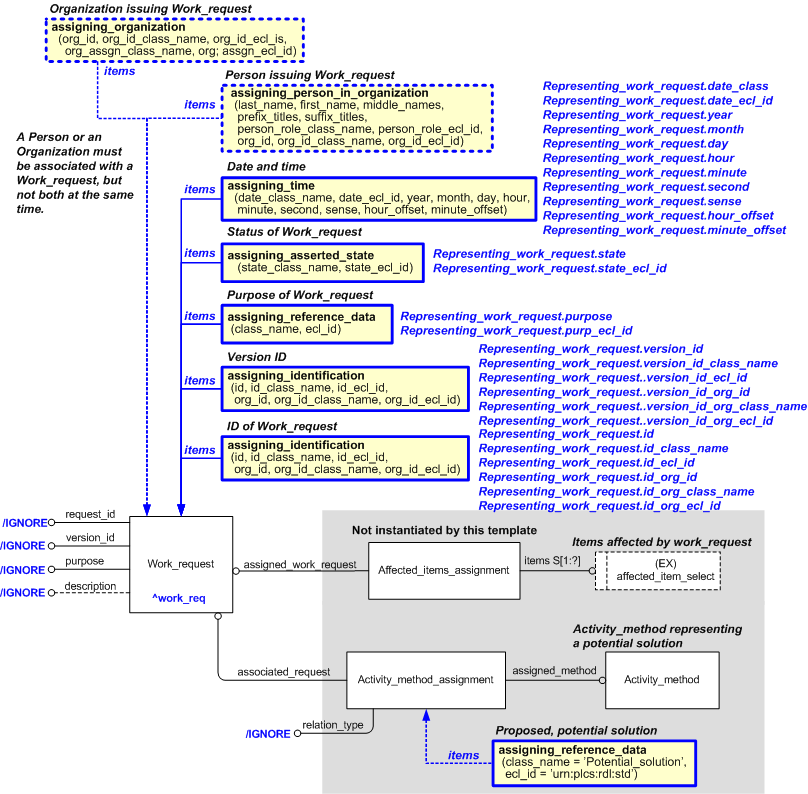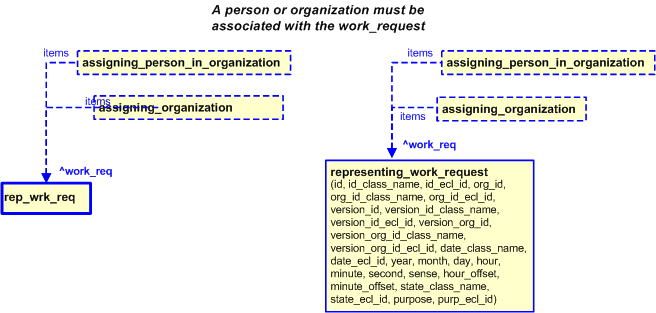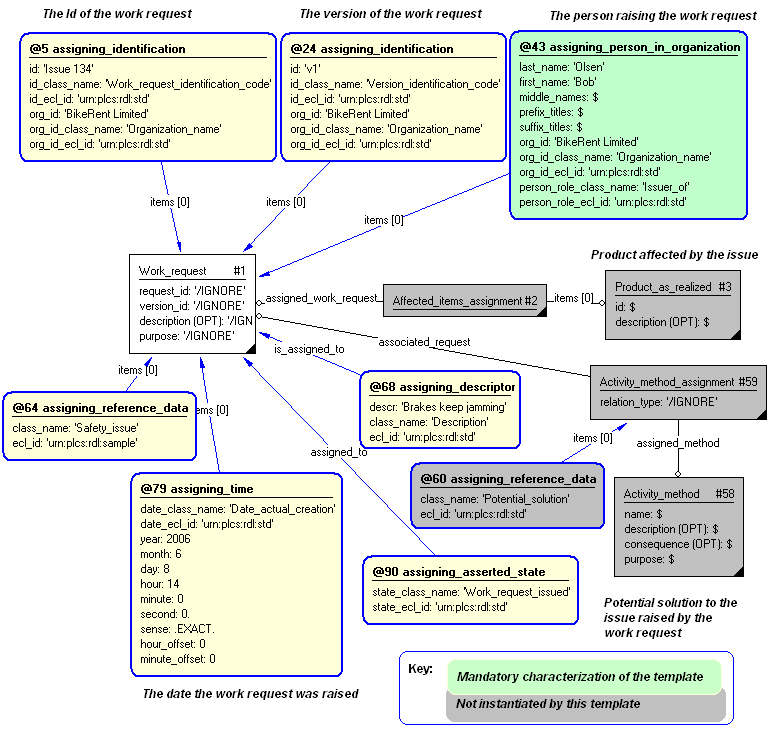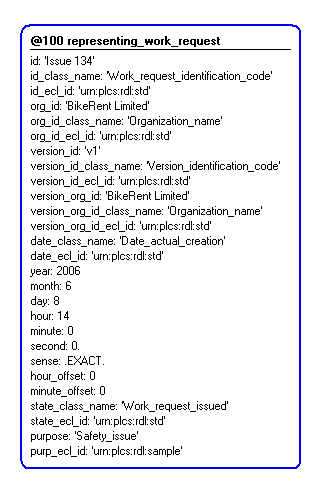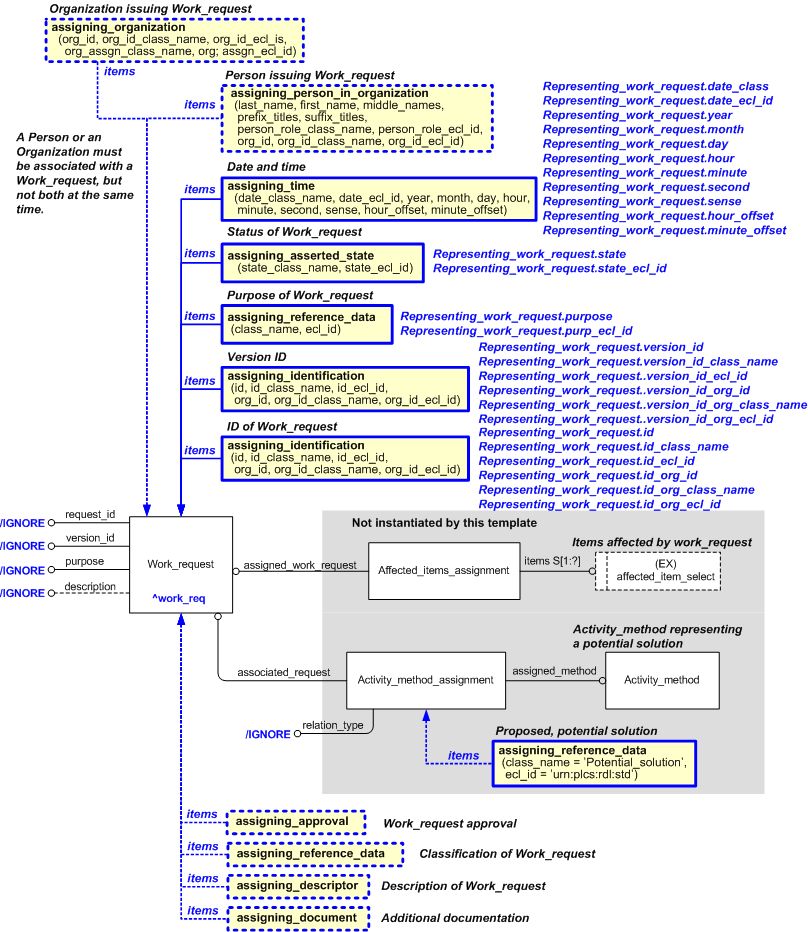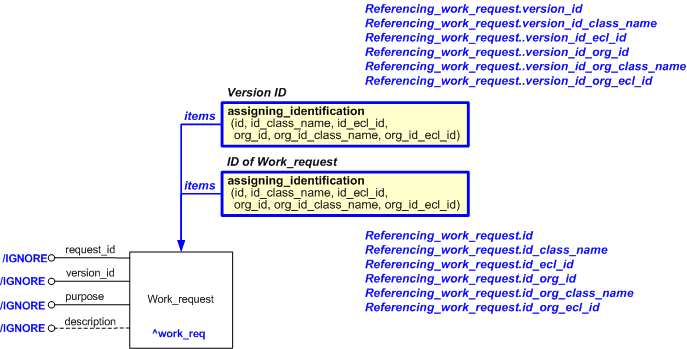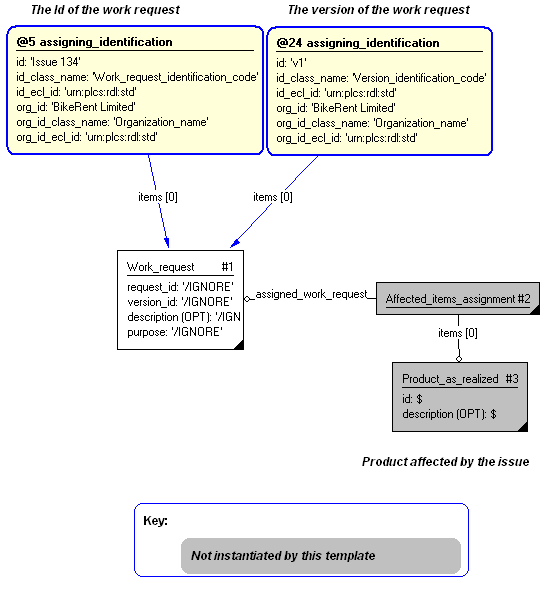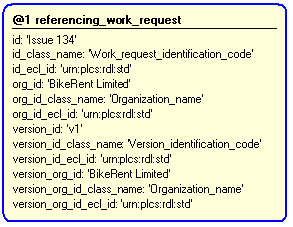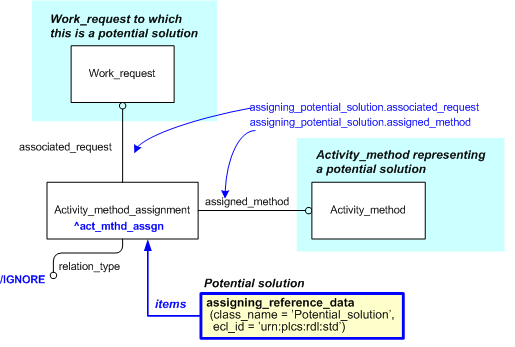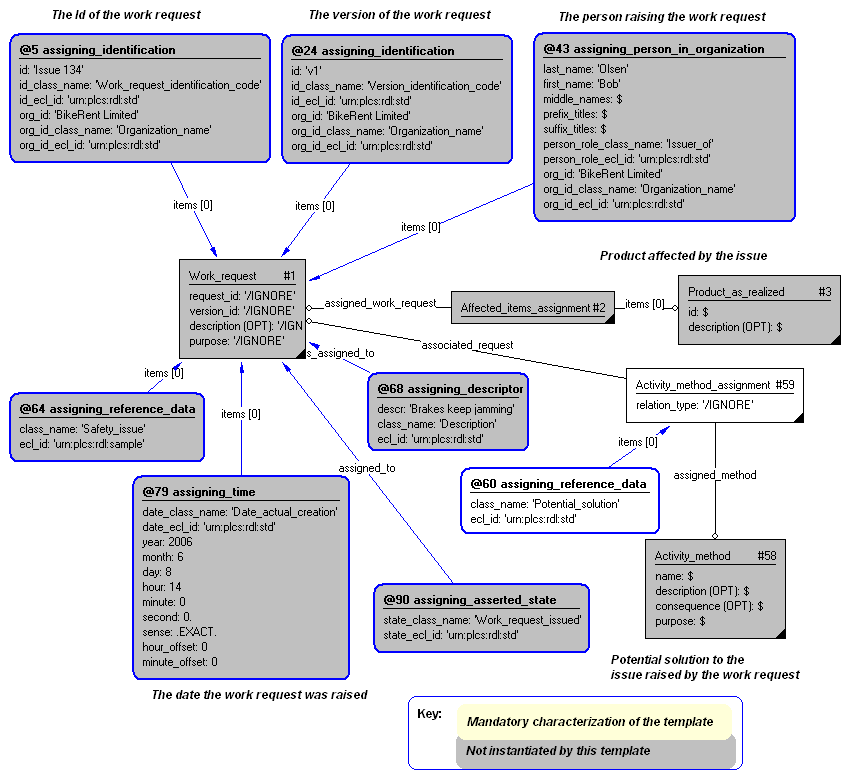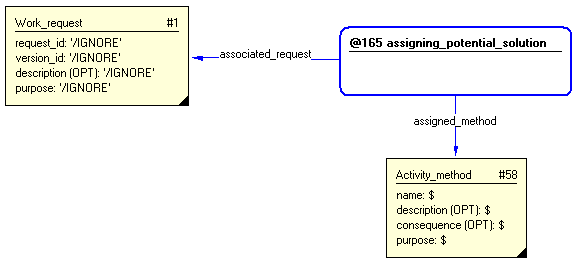| Capability (C066):— representing_work_request |
Date: 2008/01/28 17:20:40
Revision: 1.32
|
This section provides a business level overview of this capability.
A work request is an issue that has been raised by someone and
requires that some work be done to address it. In order to manage the
progress of the issue, it is identified, approved and has an
associated state.
The basic business model for requesting and authorizing work that is supported by ISO
10303-239 PLCS is shown in Figure 1.
First an issue is identified that requires some work to be undertaken to resolve - a work
request - This is the
subject of this capability. When the issue is identified a number of potential solutions may be
proposed. Having requested some work, the work is then authorized - the work_order. Having
authorized work to take place, an authorized activity is established and a series of activities are
planned. The changes that are expected as a result of the work are related to the planned
activities. The planned activities are then executed and a record of each activity undertaken
is maintained as well as any results of the work.
Figure 1 — Requesting and authorizing work
This section provides an overview of the information model that supports
this capability.
The information required to represent a request for work, the resulting work authorization and
consequent work, is summarized
in the EXPRESS-G diagram in Figure 2 below and described in the
following sections.
The shading on the diagram indicates which parts of the model are covered by which
capabilities. Namely:
NOTE
The EXPRESS-G is not complete. For the complete EXPRESS see the
modules:
Work request,
Work request characterized,
Work order,
Work order characterized,
Activity and
Activity as realized.
The EXPRESS-G diagram in Figure 3 shows the information required to
represent the request for work.
Figure 2 — EXPRESS-G for requesting, authorizing and doing work
Figure 3 — EXPRESS-G for requesting work
Identification
An issue is represented by the entity:
Work_request.
The
Work_request
is identified by using the template
assigning_identification to
assign an identifier as described in
C001: assigning_identifiers.
The parameters used are given in
template table:
Template @1(Figure 3)
![[warning:]]() Error T7a: Template_table name="assigning_identification" figure_id="expressg_char"
Error T7a: Template_table name="assigning_identification" figure_id="expressg_char"
Param id in assigning_identification has not been defined in the template_table
![[warning:]]() Error T7a: Template_table name="assigning_identification" figure_id="expressg_char"
Error T7a: Template_table name="assigning_identification" figure_id="expressg_char"
Param org_id in assigning_identification has not been defined in the template_table
![[warning:]]() Error T7a: Template_table name="assigning_identification" figure_id="expressg_char"
Error T7a: Template_table name="assigning_identification" figure_id="expressg_char"
Param org_id_class_name in assigning_identification has not been defined in the template_table
![[warning:]]() Error T7a: Template_table name="assigning_identification" figure_id="expressg_char"
Error T7a: Template_table name="assigning_identification" figure_id="expressg_char"
Param org_id_ecl_id in assigning_identification has not been defined in the template_table
![[warning:]]() Error T7a: Template_table name="assigning_identification" figure_id="expressg_char"
Error T7a: Template_table name="assigning_identification" figure_id="expressg_char"
Param items in assigning_identification has not been defined in the template_table
| Template @1 (Figure 3): assigning_identification
|
| Description |
The following parameters are set to represent the assignment of an identifier
to a
Work_request.
|
| Parameter name: |
Parameter value: |
Parameter description: |
| id_class_name |
Work_request_identification_code |
The name of the class used to classify the identifier (@id) and so
provide the role or reason for the identification.
|
| id_ecl_id |
urn:plcs:rdl:std |
The id of the
External_class_library
storing the @id_class_name.
|
| id |
? |
The identifier being assigned.
|
| org_id |
? |
The identifier of the organization that
"owns" the identifier.
|
| org_id_class_name |
? |
The name of the class being used to classify the
identification of the organization, or the organization name (@org_id). For example CAGE code.
|
| org_id_ecl_id |
? |
The id of the
External_class_library
storing the @org_id_class_name.
|
| items |
? |
The items to which the identification is assigned
|
The version of the
Work_request
is identified by using the template
assigning_identification to
assign a version identifier. The identification is classified as a
"Version identification code"
(urn:plcs:rdl:std:Version identification code)
The parameters used are given in
template table:
Template @1(Figure 3)
![[warning:]]() Error T7a: Template_table name="assigning_identification" figure_id="expressg_char"
Error T7a: Template_table name="assigning_identification" figure_id="expressg_char"
Param id in assigning_identification has not been defined in the template_table
![[warning:]]() Error T7a: Template_table name="assigning_identification" figure_id="expressg_char"
Error T7a: Template_table name="assigning_identification" figure_id="expressg_char"
Param org_id in assigning_identification has not been defined in the template_table
![[warning:]]() Error T7a: Template_table name="assigning_identification" figure_id="expressg_char"
Error T7a: Template_table name="assigning_identification" figure_id="expressg_char"
Param org_id_class_name in assigning_identification has not been defined in the template_table
![[warning:]]() Error T7a: Template_table name="assigning_identification" figure_id="expressg_char"
Error T7a: Template_table name="assigning_identification" figure_id="expressg_char"
Param org_id_ecl_id in assigning_identification has not been defined in the template_table
![[warning:]]() Error T7a: Template_table name="assigning_identification" figure_id="expressg_char"
Error T7a: Template_table name="assigning_identification" figure_id="expressg_char"
Param items in assigning_identification has not been defined in the template_table
| Template @2 (Figure 3): assigning_identification
|
| Description |
The following parameters are set to represent the assignment of a version identifier
to a
Work_request.
|
| Parameter name: |
Parameter value: |
Parameter description: |
| id_class_name |
Version_identification_code |
The name of the class used to classify the identifier (@id) and so
provide the role or reason for the identification.
|
| id_ecl_id |
urn:plcs:rdl:std |
The id of the
External_class_library
storing the @id_class_name.
|
| id |
? |
The identifier being assigned.
|
| org_id |
? |
The identifier of the organization that
"owns" the identifier.
|
| org_id_class_name |
? |
The name of the class being used to classify the
identification of the organization, or the organization name (@org_id). For example CAGE code.
|
| org_id_ecl_id |
? |
The id of the
External_class_library
storing the @org_id_class_name.
|
| items |
? |
The items to which the identification is assigned
|
Affected items
If the issue is against a given item, such as a
Product_as_realized
then the
Affected_items_assignment
relationship is used to relate the
Work_request
to the
Product_as_realized.
NOTE
The method for referencing a
Product_as_realized
is described in the capability
referencing_product_as_individual
![[warning:]](../../../../images/dex/warning.gif) Error C1: Capability referencing_product_as_individual not in dex_index.xml
Error C1: Capability referencing_product_as_individual not in dex_index.xml
.
If a potential solution to the issue is to be recorded when it is
raised, then the approach is recorded using an instantiation of
Activity_method.
NOTE
Details of
Activity_method
are provided in
C032: representing_activity.
Raised by
The person or organization that raised the issue is
represented by assigning a
Person_in_organization
or
Organization
(using the relationship
Organization_or_person_in_organization_assignment)
to the
Work_request.
The assignment is defined by the templates
assigning_organization
and
assigning_person_in_organization
respectively.
Date
The date when the
Work_request
was raised can be represented by assigning a date
(using the relationship
Date_or_date_time_assignment)
to the
Work_request.
NOTE
The assignment of dates is described the template
assigning_calendar_date and
assigning_time.
Purpose
The purpose of the Work_request, is represented by
reference data. For example, the issue being raised may be due to cost, safety, process
improvement, each of which would be represented by reference data.
Work request life cycle
There are two aspects to the life cycle of a
Work_request.
The first is its approval status. The second is the state of the
Work_request.
The approval and state stages are dependent on the business
processes deployed within an enterprise. An example is the
Work_request
may be approved as a valid issue, and then have the state, "raised
as an issue". Once the issue has been addressed it may have the
state "addressed".
The approval status of the
Work_request
is represented by
assigning_approval.
The precise meaning of a state is represented by assigning reference data
to the
State
as described in the capability
C010: assigning_reference_data and template
assigning_asserted_state.
A
Work_request
is approved by assigning an approval to it using the template
assigning_approval.
There are two mechanisms for associating states with a
Work_request in
the model. Namely by using
State
and
State_definition
as described in the capabilities
C007: representing_state_type and
C041: representing_state_observed, or by using
Work_request_status.
In order to only have a single approach to associating a state is
recommended to only use
C007: representing_state_type and
C041: representing_state_observed.
The
Work_request_status
is included for compatibility with the PDM Schema.
If a PDM Schema file is read containing instances
Work_request_status
they should be mapped to
C041: representing_state_observed.
An example showing an issue raised against an individual product, such as a
bike built from that design is shown in Figure 2 below.
The issue is represented by an instance of
Work_request (#1) and has been raised against a bike, represented by an instance of
Product_as_realized (#3). In order to simply the diagram, the details of the using an instance of
Product_as_realized (#3) have not been shown. Details are provided in the capability
C045: representing_product_as_individual.
The Work_request (#1) is related to the bike by an
instance of
Affected_items_assignment (#2).
A potential solution to the issue has been identified,
Activity_method (#58), and related to the
Work_request (#1) by an instance of
Activity_method_assignment (#59).
In order to simply the diagram, the details of the using an instance of Activity_method_assignment (#59) have not been shown. Details are provided in the capability
C032: representing_activity.
Figure 2 — Identifying an issue
This section specifies how the information model can be further
characterized by the assignment of additional information such as
dates, approvals and people or organizations.
The following characterizations may apply.
A text string providing a description of the
Work_request
is represented by the template
assigning_descriptor.
If more documentation
is necessary to describe the issue, documents can be assigned
using the
Document_assignment
relationship as described in capability
referencing_documents
![[warning:]](../../../../images/dex/warning.gif) Error C1: Capability referencing_documents not in dex_index.xml
Error C1: Capability referencing_documents not in dex_index.xml
and template
assigning_document.
The following sections define a set of templates for the capability,
where a template is a specification of a set of entities that need to
be instantiated to represent a given set of information.
This section specifies the template representing_work_request.
NOTE
An explanation of a template and the associated instantiation path is
provided in the
Template overview
section.
This template describes how to represent a work request.
The EXPRESS-G diagram in
Figure
1
shows the templates and EXPRESS entities that are required
to represent the template
"representing_work_request".
The text highlighted in blue shows the template parameters.
Figure 1 — An EXPRESS-G representation of the Information model for representing_work_request
The graphic for the template to be used in other EXPRESS-G diagrams
is shown in Figure
2
below.
Figure 2 —
The graphical representation of representing_work_request template
The following input parameters are defined for this template:
id_class_name (Default=Work_request_identification_code,Type='CLASS')
The name of the class used to classify the identifier and so
provide the role or reason for the identification.
The following classes and their sub-classes can be used:
id_ecl_id (Default=urn:plcs:rdl:std,Type='URN')
The identifier of the organization that
"owns" the identifier.
The name of the class being used to classify the
identification of the organization. For example CAGE code.
The following classes and their sub-classes can be used:
The version identifier being assigned to the
Work_request.
NOTE
If the version is not known use /NULL.
The name of the class used to classify the identifier and so
provide the role or reason for the identification.
The following classes and their sub-classes can be used:
The identifier of the
External_class_library
storing the class provide by the input parameter @version_id_class_name
The identifier of the organization that
"owns" the version identifier.
The name of the class being used to classify the
identification of the organization that
"owns" the version identifier. For example CAGE code.
The following classes and their sub-classes can be used:
The identifier of the
External_class_library
storing the class provide by the input parameter @version_org_id_class_name.
The name of the class defining the role of the date assigned to the
Work_request
E.g. the date the
Work_request
was raised.
The following classes and their sub-classes can be used:
The identifier of the
External_class_library
storing the class provide by the input parameter @date_class_name.
The year component of the date and time the work request was raised.
The month component of the date and time the work request was raised.
The day component of the date and time the work request was raised.
The hour component of the date and time the work request was raised.
The minute component of the date and time the work request was raised.
This parameter is optional. If not given, it will remain unset.
The second component of the date and time the work request was raised.
This parameter is optional. If not given, it will remain unset.
The direction that the time the work request was raised is offset from Coordinated Universal
Time.
Enumeration values are: 'ahead', 'exact' or 'behind'.
The number of hours by which the time the work request was raised is offset from Coordinated Universal Time.
The number of minutes by which the time the work request was raised is offset from Coordinated Universal Time.
The value of this attribute need not be specified.
This parameter is optional. If not given, it will remain unset.
The class name of the
External_class
corresponding to the State_definition name.
The following classes and their sub-classes can be used:
The identifier of the
External_class_library
storing the definition of the class referenced by the parameter @state_class_name.
The following classes and their sub-classes can be used:
The identifier of the
External_class_library
storing the definition of the class referenced by the parameter @purpose.
The following reference parameters are defined for this template:
Allow the
Work_request
entity instantiated in this path to be referenced when this template is used.
Note: The
Work_request
entity can be referenced in a template path by:
%^target = $representing_work_request.work_req%
where
target
is the parameter to which the
Work_request
is bound.
The following parameter combinations specify a uniqueness constraint:
Unique constraint: Unique work request
Unique constraint: Unique work request version
Each instance of the
entity
(
Work_request)
within the data set shall be uniquely identified
by a combination of the following parameters on this
template (representing_work_request) namely:
id,
id_class_name,
id_ecl_id,
org_id,
org_id_class_name,
org_id_ecl_id,
version_id,
version_id_class_name,
version_id_ecl_id,
version_org_id,
version_org_id_class_name,
version_org_id_ecl_id.
The
instance is
referenced by the following template parameter:
work_req.
The instantiation path shown below specifies the entities that are to be
instantiated by the template.
-- Instantiate a Work_request Work_request-- Bind the Work_request to the parameter ^work_req. -- The parameter is a reference parameter so the Work_request -- entity can be referred to when this template is used. %^work_req =
Work_request%
^work_req.description = '/IGNORE'
^work_req.purpose = '/IGNORE'
^work_req.request_id = '/IGNORE'
^work_req.version_id = '/IGNORE'
-- Identify the Work_request /
assigning_identification(
id=@id,
id_class_name=@id_class_name,
id_ecl_id=@id_ecl_id,
org_id=@org_id,
org_id_class_name=@org_id_class_name,
org_id_ecl_id=@org_id_ecl_id,
items=^work_req)/
-- Identify the Work_request version /
assigning_identification(
id=@version_id,
id_class_name=@version_id_class_name,
id_ecl_id=@version_id_ecl_id,
org_id=@version_org_id,
org_id_class_name=@version_org_id_class_name,
org_id_ecl_id=@version_org_id_ecl_id,
items=^work_req)/
-- Classify the work_request /
assigning_reference_data(
class_name=@purpose,
ecl_id=@purp_ecl_id,
items=^work_req)/
-- Assign a date to the Work_request /
assigning_time(
date_class_name=@date_class_name,
date_ecl_id=@date_ecl_id,
year=@year,
month=@month,
day=@day,
hour=@hour,
minute=@minute,
second=@second,
sense=@sense,
hour_offset=@hour_offset,
minute_offset=@minute_offset,
items=^work_req)/
-- Assign a state to the Work_request /
assigning_asserted_state(
state_class_name=@state_class_name,
state_ecl_id=@state_ecl_id,
assigned_to=^work_req)/
The following entities are instantiated with attributes as specified:
The instance diagram in Figure
3
shows an example of the EXPRESS entities and templates that are instantiated by the template:
/representing_work_request(id='Issue 134', id_class_name='Work_request_identification_code', id_ecl_id='urn:plcs:rdl:std', org_id='BikeRent Limited', org_id_class_name='Organization_name', org_id_ecl_id='urn:plcs:rdl:std', version_id='v1', version_id_class_name='Version_identification_code', version_id_ecl_id='urn:plcs:rdl:std', version_org_id='BikeRent Limited', version_org_id_class_name='Organization_name', version_org_id_ecl_id='urn:plcs:rdl:std', date_class_name='Date_actual_creation', date_ecl_id='urn:plcs:rdl:std', year='2006', month='6', day='8', hour='14', minute='0', second='0', sense='EXACT', hour_offset='0', minute_offset='0', state_class_name='Work_request_issued', state_ecl_id='urn:plcs:rdl:std', purpose='Safety_issue', purp_ecl_id='urn:plcs:rdl:sample')/
(an illustration of the consolidated representing_work_request template is shown in
Figure
4 below.)
Note that the mandatory characterization by the templates
assigning_descriptor and
assigning_person_in_organization
is shown in the diagram.
Namely:
@43 /assigning_person_in_organization(last_name='Olsen', first_name='Bob', person_role_class_name='Issuer_of', person_role_ecl_id='urn:plcs:rdl:std', org_id='BikeRent Limited', org_id_class_name='Organization_name', org_id_ecl_id='urn:plcs:rdl:std')/
and:
@68 /assigning_descriptor(descr='Brakes keep jamming', class_name='descr', ecl_id='urn:plcs:rdl:std')/
Figure 3 — Entities instantiated by representing_work_request template
The instance diagram in
Figure
4
shows the graphic symbol for the template that is to be
used in other instance diagrams. The example template is:
/representing_work_request(id='Issue 134', id_class_name='Work_request_identification_code', id_ecl_id='urn:plcs:rdl:std', org_id='BikeRent Limited', org_id_class_name='Organization_name', org_id_ecl_id='urn:plcs:rdl:std', version_id='v1', version_id_class_name='Version_identification_code', version_id_ecl_id='urn:plcs:rdl:std', version_org_id='BikeRent Limited', version_org_id_class_name='Organization_name', version_org_id_ecl_id='urn:plcs:rdl:std', date_class_name='Date_actual_creation', date_ecl_id='urn:plcs:rdl:std', year='2006', month='6', day='8', hour='14', minute='0', second='0', sense='EXACT', hour_offset='0', minute_offset='0', state_class_name='Work_request_issued', state_ecl_id='urn:plcs:rdl:std', purpose='Safety_issue', purp_ecl_id='urn:plcs:rdl:sample')/
Figure 4 — Instantiation of representing_work_request template
The following section details how the
representing_work_request
template can be optionally characterized by assigning
other constructs to it. These are characterizations commonly
applied to the template. The ISO 10303-239 EXPRESS model may enable
other assignments to the entities instantiated by the template.
The EXPRESS-G diagram in Figure
5
shows the possible characterizations of the template
"representing_work_request".
Figure 5 — Characterizations for representing_work_request template
The following characterizations may apply:
Characterization Assigning person or organization
NOTE this characterization is mandatory.
Characterization Assigning documentation
NOTE this characterization is optional.
Characterization Assigning dates
NOTE this characterization is optional.
Characterization Approvals
NOTE this characterization is optional.
This section specifies the template referencing_work_request.
NOTE
An explanation of a template and the associated instantiation path is
provided in the
Template overview
section.
This template describes how to represent a reference to a work request.
The EXPRESS-G diagram in
Figure
1
shows the templates and EXPRESS entities that are required
to represent the template
"referencing_work_request".
The text highlighted in blue shows the template parameters.
Figure 1 — An EXPRESS-G representation of the Information model for referencing_work_request
The graphic for the template to be used in other EXPRESS-G diagrams
is shown in Figure
2
below.
Figure 2 — The graphical representation of the referencing_work_request template
The following input parameters are defined for this template:
id_class_name (Default=Work_request_identification_code,Type='CLASS')
The name of the class used to classify the identifier (@id) and so
provide the role or reason for the identification.
The following classes and their sub-classes can be used:
id_ecl_id (Default=urn:plcs:rdl:std,Type='URN')
The identifier of the organization that
"owns" the identifier (@id).
The name of the class being used to classify the
identification of the organization (@org_id). For example CAGE code.
The following classes and their sub-classes can be used:
The version identifier being assigned to the
Work_request.
NOTE
If the version is not known use /NULL.
The name of the class used to classify the version identifier (@version_id)and so
provide the role or reason for the identification.
The following classes and their sub-classes can be used:
The identifier of the
External_class_library
storing the class provided by the input parameter @version_id_class_name
The identifier of the organization that
"owns" the version identifier (@version_id).
The name of the class being used to classify the
identification of the organization (@version_org_id) that
"owns" the version identifier. For example CAGE code.
The following classes and their sub-classes can be used:
The identifier of the
External_class_library
storing the class provide by the input parameter @version_org_id_class_name.
The following reference parameters are defined for this template:
Allow the
Work_request
entity instantiated in this path to be referenced when this template is used.
Note: The
Work_request
entity can be referenced in a template path by:
%^target = $referencing_work_request.work_req%
where
target
is the parameter to which the
Work_request
is bound.
The following parameter combinations specify a uniqueness constraint:
Unique constraint: Unique work request
Unique constraint: Unique work request version
Each instance of the
entity
(
Work_request)
within the data set shall be uniquely identified
by a combination of the following parameters on this
template (referencing_work_request) namely:
id,
id_class_name,
id_ecl_id,
org_id,
org_id_class_name,
org_id_ecl_id,
version_id,
version_id_class_name,
version_id_ecl_id,
version_org_id,
version_org_id_class_name,
version_org_id_ecl_id.
The
instance is
referenced by the following template parameter:
work_req.
The instantiation path shown below specifies the entities that are to be
instantiated by the template.
-- Instantiate a Work_request Work_request-- Bind the Work_request to the parameter ^work_req. -- The parameter is a reference parameter so the Work_request -- entity can be referred to when this template is used. %^work_req =
Work_request%
^work_req.description = '/IGNORE'
^work_req.purpose = '/IGNORE'
^work_req.request_id = '/IGNORE'
^work_req.version_id = '/IGNORE'
-- Identify the Work_request /
assigning_identification(
id=@id,
id_class_name=@id_class_name,
id_ecl_id=@id_ecl_id,
org_id=@org_id,
org_id_class_name=@org_id_class_name,
org_id_ecl_id=@org_id_ecl_id,
items=^work_req)/
-- Identify the Work_request version /
assigning_identification(
id=@version_id,
id_class_name=@version_id_class_name,
id_ecl_id=@version_id_ecl_id,
org_id=@version_org_id,
org_id_class_name=@version_org_id_class_name,
org_id_ecl_id=@version_org_id_ecl_id,
items=^work_req)/
The following entities are instantiated with attributes as specified:
The instance diagram in Figure
3
shows an example of the EXPRESS entities and templates that are instantiated by the template:
/referencing_work_request(id='Issue 134', id_class_name='Work_request_identification_code', id_ecl_id='urn:plcs:rdl:std', org_id='BikeRent Limited', org_id_class_name='Organization_name', org_id_ecl_id='urn:plcs:rdl:std', version_id='v1', version_id_class_name='Version_identification_code', version_id_ecl_id='urn:plcs:rdl:std', version_org_id='BikeRent Limited', version_org_id_class_name='Organization_name', version_org_id_ecl_id='urn:plcs:rdl:std')/
(an illustration of the consolidated referencing_work_request template is shown in
Figure
4 below.)
Figure 3 — Entities instantiated by referencing_work_request template
The instance diagram in
Figure
4
shows the graphic symbol for the template that is to be
used in other instance diagrams. The example template is:
/referencing_work_request(id='Issue 134', id_class_name='Work_request_identification_code', id_ecl_id='urn:plcs:rdl:std', org_id='BikeRent Limited', org_id_class_name='Organization_name', org_id_ecl_id='urn:plcs:rdl:std', version_id='v1', version_id_class_name='Version_identification_code', version_id_ecl_id='urn:plcs:rdl:std', version_org_id='BikeRent Limited', version_org_id_class_name='Organization_name', version_org_id_ecl_id='urn:plcs:rdl:std')/
Figure 4 — Instantiation of referencing_work_request template
No common characterizations of the template
referencing_work_request
have been identified. However, the ISO 10303-239 EXPRESS model
may enable other assignments to the entities instantiated by the template.
This section specifies the template assigning_potential_solution.
NOTE
An explanation of a template and the associated instantiation path is
provided in the
Template overview
section.
This template describes how to represent a proposed solution for a work request.
The EXPRESS-G diagram in
Figure
1
shows the templates and EXPRESS entities that are required
to represent the template
"assigning_potential_solution".
The text highlighted in blue shows the template parameters.
Figure 1 — An EXPRESS-G representation of the Information model for assigning_potential_solution
The graphic for the template to be used in other EXPRESS-G diagrams
is shown in Figure
2
below.
Figure 2 —
The graphical representation of assigning_potential_solution template
The following input parameters are defined for this template:
The following reference parameters are defined for this template:
%^target = $assigning_potential_solution.act_mthd_assgn%
The instantiation path shown below specifies the entities that are to be
instantiated by the template.
The following entities are instantiated with attributes as specified:
The instance diagram in Figure
3
shows an example of the EXPRESS entities and templates that are instantiated by the template:
/assigning_potential_solution(value='Bike must be light-weight')/
(an illustration of the consolidated assigning_potential_solution template is shown in
Figure
4 below.)
Figure 3 — Entities instantiated by assigning_potential_solution template
The instance diagram in
Figure
4
shows the graphic symbol for the template that is to be
used in other instance diagrams. The example template is:
/assigning_potential_solution(value='Bike must be light-weight')/
Figure 4 — Instantiation of assigning_potential_solution template
No common characterizations of the template
assigning_potential_solution
have been identified. However, the ISO 10303-239 EXPRESS model
may enable other assignments to the entities instantiated by the template.
This capability
"Representing a work request" is related to the
following capabilities:
This capability
"Representing a work request" is dependent on
the following capabilities:
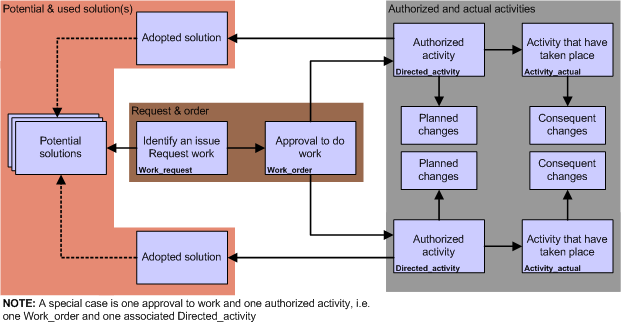

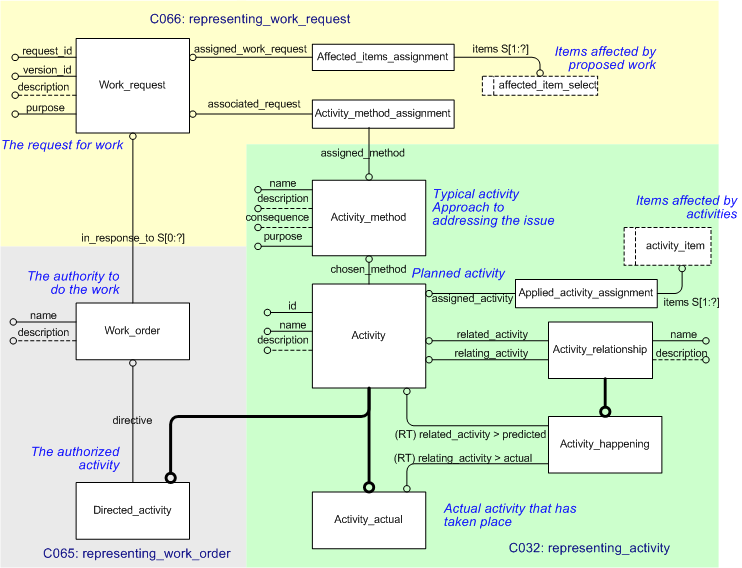
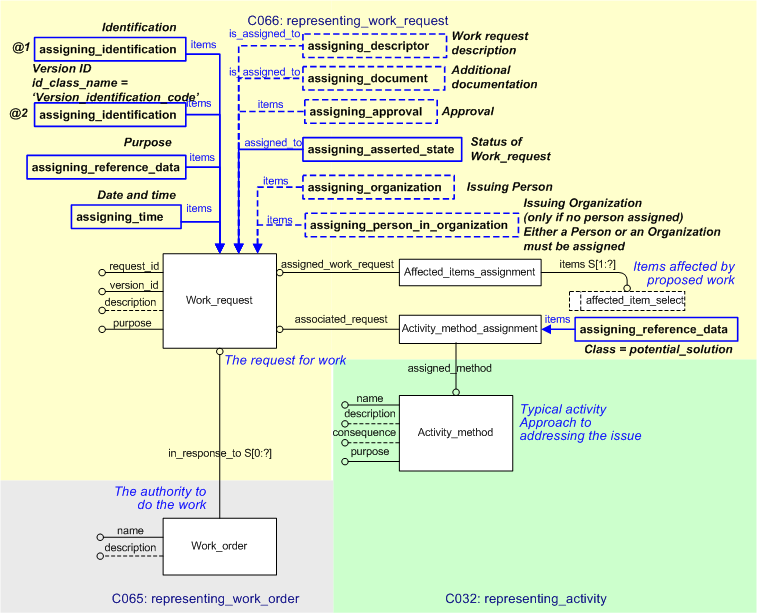
![]() Error C1: Capability referencing_product_as_individual not in dex_index.xml
Error C1: Capability referencing_product_as_individual not in dex_index.xml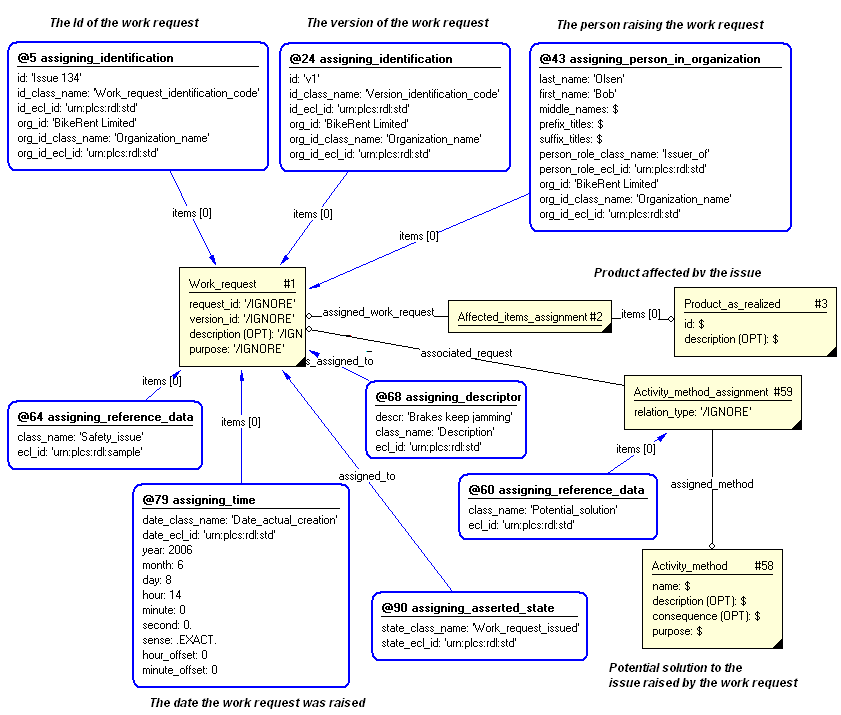
![]() Error C1: Capability referencing_documents not in dex_index.xml
Error C1: Capability referencing_documents not in dex_index.xml